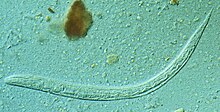Strongyloides (from Greek strongylos, round, + eidos, resemblance), anguillula, or threadworm is a genus of small nematode parasites, belonging to the family Strongylidae, commonly found in the small intestine of mammals (particularly ruminants), that are characterized by an unusual lifecycle that involves one or several generations of free-living adult worms.
Human infection, strongyloidiasis, is caused by
- Strongyloides stercoralis, widespread in all tropical regions
- Strongyloides fuelleborni, a parasite of primates in African and Asian tropics and of humans in African tropics and New Guinea
- Strongyloides papillosus, found in cattle, pigs, sheep, goats, rabbits, and rats
- Strongyloides ransomi, found in pigs[2]
- Strongyloides ratti, found in rats
- Strongyloides myopotami, found in coypu (nutria), causes dermatitis similar to strongyloidiasis.[3] The condition is also called nutria itch.[4]
Treatment for strongyloides infection is ivermectin or thiabendazole.[5]
References
edit- ^ a b c d e f g h i j k l m n o p q r "Strongyloides - Overview". Encyclopedia of Life.
- ^ "Thread worm (Strongyloides ransomi) - Managing Pig Health and Treating Pig Dieases on ThePigSite.com". The Pig Site. Archived from the original on 2018-02-03. Retrieved 2018-02-03.
- ^ "Strongyloidiasis: Background, Pathophysiology, Etiology". 2 February 2019 – via eMedicine.
{{cite journal}}: Cite journal requires|journal=(help) - ^ Bonilla, Hector F. MD; Blanchard, Diane H. MD; Sanders, Richard MD (June 2000). "Nutria Itch". Archives of Dermatology. 136 (6). Vol. 136, No. 6: JAMA Dermatology: 804–805. doi:10.1001/archderm.136.6.804-a. PMID 10871960.
{{cite journal}}: CS1 maint: location (link) - ^ Eldredge, Debra M.; Carlson, Delbert G.; Carlson, Liisa D.; Giffin, James M. (2008). Cat Owner's Home Veterinary Handbook. p. 66.
